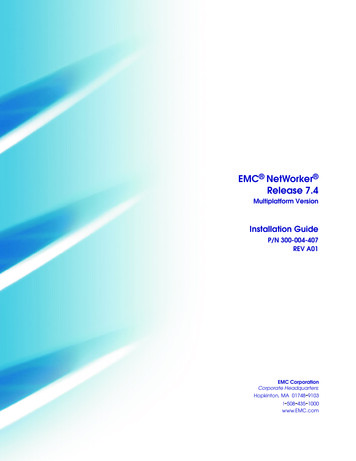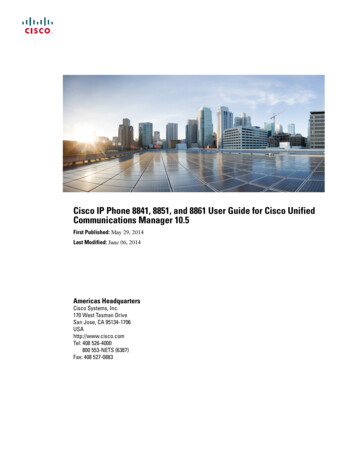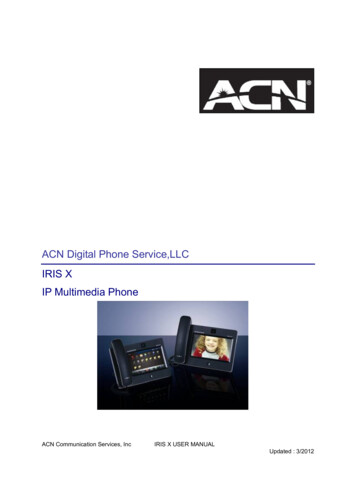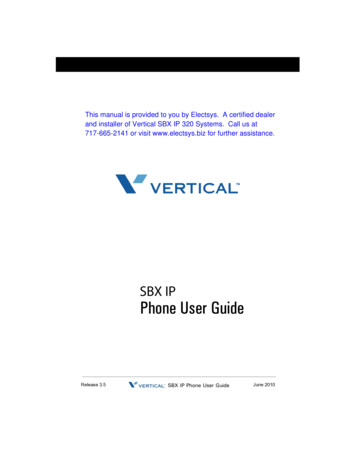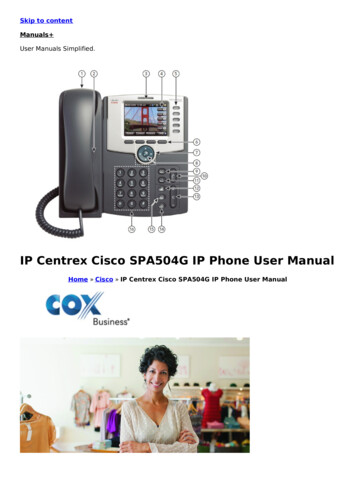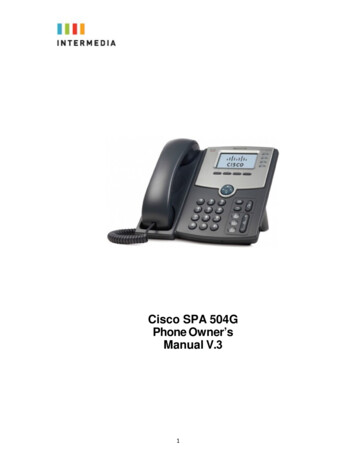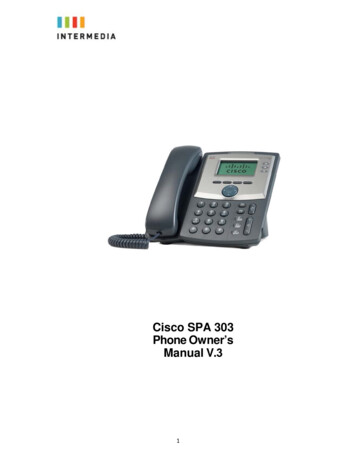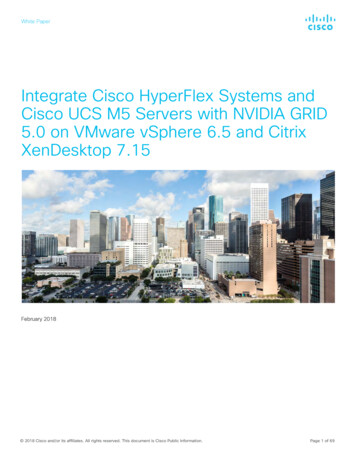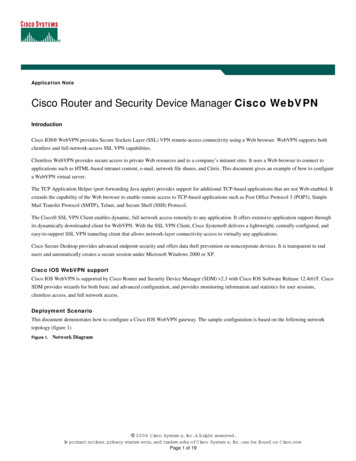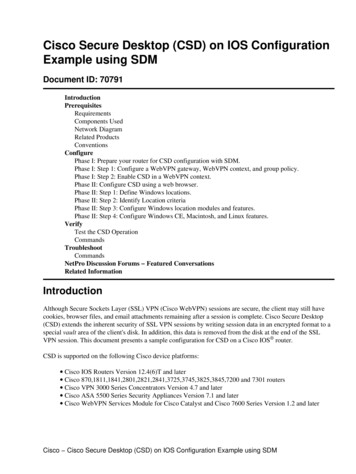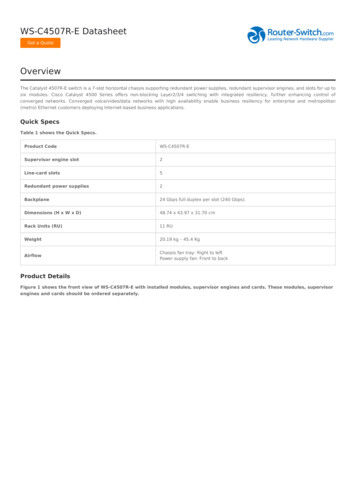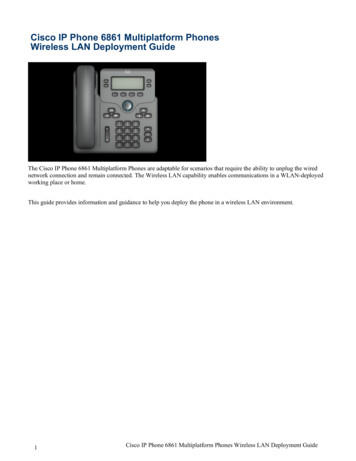
Transcription
Cisco IP Phone 6861 Multiplatform PhonesWireless LAN Deployment GuideThe Cisco IP Phone 6861 Multiplatform Phones are adaptable for scenarios that require the ability to unplug the wirednetwork connection and remain connected. The Wireless LAN capability enables communications in a WLAN-deployedworking place or home.This guide provides information and guidance to help you deploy the phone in a wireless LAN environment.1Cisco IP Phone 6861 Multiplatform Phones Wireless LAN Deployment Guide
Revision HistoryDateComments08/03/19Initial version08/06/19Updated based on review comments2Cisco IP Phone 6861 Multiplatform Phones Wireless LAN Deployment Guide
ContentsTable of ContentsRevision History . 2Contents . 3WLAN Capability Overview . 4Supported Frequencies and Channels . 4Requirements . 4Site Requirements . 4Wireless LAN . 5Protocols . 5Regulatory. 5Security . 6Configure Wireless LAN . 8Configure Mainstream Home-Based AP. 8Cisco Autonomous Access Points . 8802.11 Network Settings . 9WLAN Settings . 12Call Admission Control (CAC) . 16QoS Policies . 17Advanced Settings . 20Configure Wireless Connection on Your Phone . 21Wireless LAN Profiles (Web Page) . 21Wireless LAN Profiles (on Phone Screen) . 22Wireless LAN with WPS (on Phone Screen) . 25WLAN Connection Troubleshooting . 27View Wi-Fi Status and Messages . 27Wi-Fi Message References . 28Capture a Screenshot of the Phone Display . 29Capture Packets . 29Report PRT on the Phone . 30Additional Documentation . 323Cisco IP Phone 6861 Multiplatform Phones Wireless LAN Deployment Guide
WLAN Capability OverviewThe Cisco IP Phone 6861 Multiplatform Phones extend collaboration to wireless network with 802.11 implementation.You can use the Cisco Unified Communication applications on the phone with either wired or wireless network.With an enhancement on QoS control, the implementation of 802.11 permits time-sensitive applications, such as voice, tooperate efficiently over wireless LAN (WLAN) deployment. These extensions provide bandwidth allocation ahead of aservice if the AP supports it too, which guarantees the efficiency and good experience of communication for traffic overthe air.Since WLAN uses unlicensed spectrum, it may experience interference from other devices using the unlicensed spectrum.The proliferation of devices in the 2.4 GHz spectrum, such as Bluetooth headsets, Microwave ovens, and cordlessconsumer phones, means that the 2.4 GHz spectrum may contain more congestion than other spectrums. The 5 GHzspectrum has far fewer devices operating in this spectrum and is the preferred spectrum to operate the phone in order totake advantage of the 802.11a/n data rates available.Despite the optimizations that Cisco has implemented in Cisco IP Phone 6861 Multiplatform Phones, we can’t guaranteeuninterrupted communication in using the unlicensed spectrum, and there may be the possibility of voice gaps of up toseveral seconds during conversations. Adherence to these deployment guidelines will reduce the likelihood of these voicegaps being present, but there is always the possibility.Through the use of unlicensed spectrum, and the inability to guarantee the delivery of messages to a WLAN device, theCisco IP Phone 6861 Multiplatform Phone is not intended to be used as a medical device and should not be used to makeclinical decisions.Supported Frequencies and ChannelsThe following table lists the frequencies and channels that Cisco IP Phone 6861 Multiplatform Phones support.Part NumberCP-6861-3PW-CE-K9 CP-6861-3PW-NA-K9 CP-6861-3PW-UK-K9 CP-6861-3PW-AU-K9 DescriptionCisco MPPPhone 6861Peak Antenna GainFrequency RangesAvailableChannelsChannel Set2.412-2.472GHz: 2.44 dBi2.412 - 2.472 GHz131-135.150-5.350GHz: 0.53 dBi5.180 - 5.240 GHz436,40,44,485.470-5.725GHz: 0.7 dBi5.260 - 5.320 GHz452,56,60,645.500 - 5.700 GHz11100-1445.745 - 5.825 GHz5149,153,157,161,165RequirementsBefore deploying your phone, ensure that the requirements for the site and WLAN network are met.Site RequirementsBefore deploying the phone into a production environment, the site WLAN network deployment must be properlyconfigured to accommodate more devices. Typically, there is less interference in the 5 GHz band and more nonoverlapping channels, so 5 GHz is the preferred band for operation and even more highly recommended when the phone isto be used in a mission-critical environment.The wireless LAN must be validated to ensure it meets the requirements to deploy the phone.SignalThe signal coverage should be no lower than -67 dBm to ensure that the phone always has adequate signal.Channel UtilizationChannel Utilization levels should be kept under 40%.The phone converts the 0-255 scale value to a percentage, so 105 would equate to around 40% on the phone.4Cisco IP Phone 6861 Multiplatform Phones Wireless LAN Deployment Guide
NoiseNoise levels should not exceed -92 dBm, which allows for a Signal to Noise Ratio (SNR) of 25 dB where a -67 dBmsignal should be maintained.Ensure that the upstream signal from the phone meets the access point’s SNR for the transmitted data rate.Packet Loss / DelayPer voice guidelines, packet loss should not exceed 1%. Otherwise, the voice quality can be degraded significantly.Jitter should be kept at the minimal ( 100 ms).Retries802.11 retransmission should be less than 20%.MultipathMultipath should be kept to the minimal to create nulls and reduce signal levels.Number of allowed devicesThe total number of connected devices to a given AP is no more than 10.Separate SSIDWe recommend that you put the phone in a separate SSID to guarantee voice traffic on the phone. Sharing the sameSSID with other devices may impact phone calls on the phone when the other devices are using heavy network traffic.For voice deployments, it is suggested to use 802.11a/n for voice and use 802.11b/g/n for data.Wireless LANThe Cisco IP Phone 6861 Multiplatform Phones are recommended to work with the following Wireless LAN solutions: Mainstream AP for home use Cisco Autonomous Access Points Minimum 12.4(21a)JY Recommended 12.4(25d)JA2, 15.2(4)JB6, 15.3(3)JDProtocolsThe supported wireless LAN protocols include the following: 802.11a, b, d, e, g, h, i, n Wi-Fi MultiMedia (WMM) Traffic Specification (TSPEC) Traffic Classification (TCLAS)RegulatoryWorld Mode (802.11d) allows a client to be used in different regions, where the client can adapt to use the channels andtransmit powers advertised by the access point in the local environment.5Cisco IP Phone 6861 Multiplatform Phones Wireless LAN Deployment Guide
The phone operates best when the access point is 802.11d-enabled. The AP can determine the channels and transmitpowers per the local region.Enable World Mode (802.11d) for the corresponding country where the access point is located.Some 5 GHz channels are also used by radar technology, which requires that the 802.11 client and access point to be802.11h-compliant to utilize those radar frequencies (DFS channels). 802.11h requires 802.11d to be enabled.The Cisco IP Phone 6861 Multiplatform Phone will passively scan DFS channels first before engaging in active scans ofthose channels.If 802.11d is not enabled, then the phone can attempt to connect to the access point using reduced transmit power.Below are the countries and their 802.11d codes that the phone supports.Argentina (AR)Australia (AU)Austria (AT)Bahrain (BH)Belgium (BE)Brazil (BR)Bulgaria (BG)Canada (CA)Chile (CL)Colombia (CO)Costa Rica (CR)Croatia (HR)Cyprus (CY)Czech Republic (CZ)Denmark (DK)Dominican Republic (DO)Ecuador (EC)Egypt (EG)Estonia (EE)Finland (FI)France (FR)Germany (DE)Gibraltar (GI)Greece (GR)Hong Kong (HK)Hungary (HU)Iceland (IS)India (IN)Ireland (IE)Israel (IL)Italy (IT)Japan (JP)Korea (KR)Latvia (LV)Liechtenstein (LI)Lithuania (LT)Luxembourg (LU)Macau (MO)Macedonia (MK)Malaysia (MY)Malta (MT)Mexico (MX)Monaco (MC)Montenegro (ME)Netherlands (NL)New Zealand (NZ)Nigeria (NG)Norway (NO)Oman (OM)Panama (PA)Paraguay (PY)Peru (PE)Philippines (PH)Poland (PL)Portugal (PT)Puerto Rico (PR)Romania (RO)Russian Federation (RU)Saudi Arabia (SA)Serbia (RS)Singapore (SG)Slovakia (SK)Slovenia (SI)South Africa (ZA)Spain (ES)Sweden (SE)Switzerland (CH)Taiwan (TW)Thailand (TH)Turkey (TR)Ukraine (UA)United Arab Emirates (AE)United Kingdom (GB)United States (US)Uruguay (UY)Venezuela (VE)Vietnam (VN)SecurityWhen deploying a wireless LAN, security is essential. The phone supports the following wireless security features. 6WLAN Authentication WPA2-PSK (Pre-Shared key AES encryption) WPA-PSK (Pre-Shared key TKIP encryption) WPA2 (802.1x authentication AES or TKIP encryption)Cisco IP Phone 6861 Multiplatform Phones Wireless LAN Deployment Guide
WPA (802.1x authentication TKIP or AES encryption) EAP-FAST (Extensible Authentication Protocol - Flexible Authentication via Secure Tunneling)1 EAP-TLS (Extensible Authentication Protocol - Transport Layer Security) )1 PEAP-GTC (Protected Extensible Authentication Protocol - Generic Token Card) )1 PEAP-MSCHAPv2 (Protected Extensible Authentication Protocol - Microsoft Challenge HandshakeAuthentication Protocol version 2) )1 None WLAN Encryption AES (Advanced Encryption Standard) TKIP / MIC (Temporal Key Integrity Protocol / Message Integrity Check) WEP (Wired Equivalent Protocol) 40/64 and 104/128 bitNote: An external authentication system is required.7Cisco IP Phone 6861 Multiplatform Phones Wireless LAN Deployment Guide
Configure Wireless LANConfigure Mainstream Home-Based APWhen configuring a mainstream home-based access point, ensure that:1.You enable internet access as below picture shows. The internet connection could be set up via wideband useraccount on DSL or fiber link to external network.2. You configure the local SSID and the secure mode for home/office usage as following picture shows.Cisco Autonomous Access PointsWhen configuring Cisco Autonomous Access Points, use the following guidelines:8 Configure the Data Rates as necessary Configure Quality of Service (QoS) Set the WMM Policy to Required Ensure Aironet Extensions is Enabled Disable Public Secure Packet Forwarding (PSPF) Set IGMP Snooping to EnabledCisco IP Phone 6861 Multiplatform Phones Wireless LAN Deployment Guide
802.11 Network SettingsWe recommend that you have the phone operate on the 5 GHz band only due to that there are many channels available onthis band and not as many interferers as the 2.4 GHz band has.To use the 5 GHz band, ensure that the 802.11a/n network status is Enabled.We recommend that you set 12 Mbps as the mandatory (basic) rate and 18 Mbps or higher as the supported (optional)rates. However, some environments may require 6 Mbps to be enabled as the mandatory (basic) rate.When using the 5 GHz band, up to 12 channels only is recommended to avoid any potential delay of access pointdiscovery due to having to scan many channels.For Cisco Autonomous Access Points, select Dynamic Frequency Selection (DFS) to use auto channel selection.When DFS is enabled, enable at least one band (bands 1-4).You can select Band 1 only for the access point to use a UNII-1 channel (channel 36, 40, 44, or 48).Individual access points can be configured to override the global settings to use dynamic channel and transmit powerassignment for either 5 GHz or 2.4 GHz depending on the frequency band to be used.Other access points can be enabled for Auto RF and workaround the access points that are statically configured.This may be necessary if there is an intermittent interference present in an area.The 5 GHz channel width can be configured for 20 MHz or 40 MHz if using Cisco 802.11n Access Points and 20 MHz,40 MHz, or 80 MHz if using Cisco 802.11ac Access Points.It is recommended to use the same channel width for all access points.Ensure Client Power is configured properly. Do not use the default setting of Max power for client power on CiscoAutonomous Access Points because that will not advertise DTPC to the client.Enable Dot11d for World Mode and configure the proper Country Code.Ensure Aironet Extensions is enabled.Set the Beacon Period to 100 ms and DTIM to 2.9Cisco IP Phone 6861 Multiplatform Phones Wireless LAN Deployment Guide
10Cisco IP Phone 6861 Multiplatform Phones Wireless LAN Deployment Guide
If you want to use the 2.4 GHz band, ensure that the 802.11b/g/n network status and 802.11g is enabled.Recommended to set 12 Mbps as the mandatory (basic) rate and 18 Mbps or higher as supported (optional) rates assumingthat there will not be any 802.11b-only clients connecting to the wireless LAN. However, some environments may require6 Mbps to be enabled as the mandatory (basic) rate.If 802.11b clients exist, then 11 Mbps should be set as the mandatory (basic) rate and 12 Mbps or higher as the supported(optional) rate.11Cisco IP Phone 6861 Multiplatform Phones Wireless LAN Deployment Guide
WLAN SettingsWe recommend that you set a separate SSID for the phone to connect.However, if there is an existing SSID configured to support voice-capable Cisco Wireless LAN endpoints already, thenthat WLAN can be utilized instead.The SSID to be used by the phone can be configured to only apply to a certain 802.11 radio type (e.g. 802.11a only).Enable WPA2 key management.12Cisco IP Phone 6861 Multiplatform Phones Wireless LAN Deployment Guide
13Cisco IP Phone 6861 Multiplatform Phones Wireless LAN Deployment Guide
Segment wireless voice and data into separate VLANs.Ensure that Public Secure Packet Forwarding (PSPF) is not enabled for the voice VLAN as this will prevent clients fromdirect communication when associated to the same access point. If PSPF is enabled, then the result will be no audio.14Cisco IP Phone 6861 Multiplatform Phones Wireless LAN Deployment Guide
Ensure AES is selected for encryption type.15Cisco IP Phone 6861 Multiplatform Phones Wireless LAN Deployment Guide
Configure the RADIUS servers to be used for authentication and accounting.Call Admission Control (CAC)Load-based CAC that supports multiple streams is not present on the Cisco Autonomous Access Points therefore it is notrecommended to enable CAC on Cisco Autonomous Access points.The Cisco Autonomous Access Point only allows for one stream and the stream size is not customizable, therefore SRTPand barge do not work if CAC is enabled.If Admission Control for Voice or for Video is enabled on the Cisco Autonomous Access Point, the admission must beunblocked on the SSID as well. In recent releases, the admission is unblocked by default.dot11 ssid voicevlan 3authentication open eap eap methodsauthentication network-eap eap methodsauthentication key-management wpa version 2 dot11radmit-traffic16Cisco IP Phone 6861 Multiplatform Phones Wireless LAN Deployment Guide
QoS PoliciesConfigure the following QoS policy on the Cisco Autonomous Access Point to enable DSCP to CoS (WMM UP)mapping.This allows packets to be placed into the proper queue as long as those packets are marked correctly when received at theaccess point level.17Cisco IP Phone 6861 Multiplatform Phones Wireless LAN Deployment Guide
To enable QBSS, select Enable and check Dot11e.If Dot11e is checked, then both CCA versions (802.11e and Cisco version 2) will be enabled.Ensure IGMP Snooping is enabled.Ensure Wi-Fi MultiMedia (WMM) is enabled.18Cisco IP Phone 6861 Multiplatform Phones Wireless LAN Deployment Guide
If the Stream feature is enabled either directly or via selecting Optimized Voice for the radio access category in the QoSconfiguration section, then use the default settings, whe
5 Cisco IP Phone 6861 Multiplatform Phones Wireless LAN Deployment Guide Noise Noise levels should not exceed -92 dBm, which allows for a Signal to Noise Ratio (SNR) of 25 dB where a -67 dBm signal should be maintained. Ensure that the upstream signal from the phone meets the access point’s SNR for the tr
